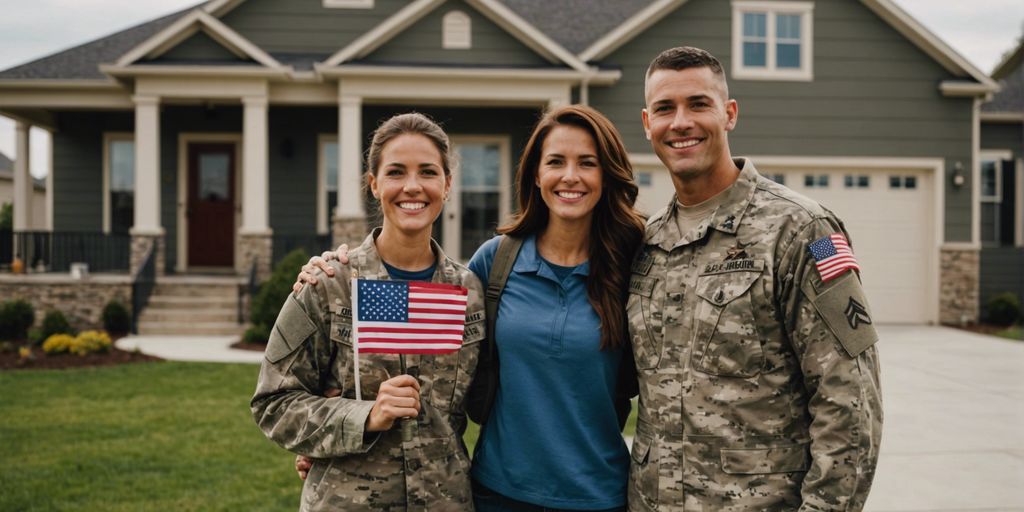VA construction loans offer veterans and active-duty service members a unique opportunity to finance the construction of their dream homes. Unlike traditional mortgages, these loans provide funds in stages as construction progresses, ensuring that the project stays on track. This article will explore the ins and outs of VA construction loans, including their benefits, eligibility criteria, application process, and more.
Important points
- The purpose of VA construction loans is to enable veterans and active-duty service members to build new homes or renovate existing ones.
- There are two types of VA construction loans: onetime close and two-time close, each with its own set of advantages and requirements.
- Eligibility for a VA construction loan includes meeting service requirements, credit and income standards, and working with a VA-approved builder.
- The application process involves finding a VA-approved lender, submitting construction plans, and going through loan approval and disbursement stages.
- Alternatives to VA construction loans include traditional construction loans, FHA 203k loans, and USDA rehab loans, each with different criteria and benefits.
Understanding VA Construction Loans
What is a VA Construction Loan?
A VA construction loan is a short-term loan designed to cover the cost of building a home. Unlike regular mortgages, you don’t receive a lump sum with this sort of financing. Instead, the lender releases the funds to you through a series of draws as you complete different stages of the construction process. The money can finance the land or lot purchase and the actual building of the home, plus the loan funding fee. However, you can’t finance any other closing costs with this loan.
Types of VA Construction Loans
There are primarily two types of VA construction loans:
- OneTime Close Construction Loan: This loan combines the construction loan and the permanent mortgage into a single loan, reducing the need for multiple closings and saving on closing costs.
- Two-Time Close Construction Loan: This involves two separate loans—one for the construction phase and another for the permanent mortgage. This option may offer more flexibility but can be more complex and costly because of multiple closings.
Benefits of VA Construction Loans
VA construction loans offer several benefits, including:
- No Down Payment: Eligible veterans can finance 100% of the construction costs.
- Competitive Interest Rates: These loans often come with lower interest rates compared to conventional construction loans.
- No Private Mortgage Insurance (PMI): Unlike conventional loans, VA loans do not require PMI, which can cause significant savings.
- Flexible Terms: Borrowers can choose from various loan terms to suit their financial situation.
Building a house with a VA loan is a fairly involved process, but construction loans are complex. Working with a VA-approved lender and builder can simplify the process and ensure compliance with VA requirements.
Eligibility Criteria for VA Construction Loans
To qualify for a VA construction loan, you must meet specific service requirements. These vary depending on your service status and history. Active-duty members are eligible after 90 days of continuous service. Veterans who served between 1990 and now can meet eligibility with any of:
- 181 days of active duty service during peacetime
- 90 days of active duty service during wartime
- 6 years of service with the National Guard or Reserves, or 90 days under Title 32 with at least 30 consecutive active days
- Surviving spouse of a service member who died in the line of duty or suffers a service-connected disability
Financial stability is crucial for obtaining a VA construction loan. Lenders will assess your credit score, income, and debt-to-income (DTI) ratio. While the VA does not set a minimum credit score, most lenders require a score of at least 620. Your DTI ratio should not exceed 41%.
| Criteria | Requirement |
|---|---|
| Minimum Credit Score | 620 |
| Maximum DTI Ratio | 41% |
The builder you choose must be VA-approved, ensuring they meet the standards and regulations. The property itself must also meet specific criteria, including being your primary residence and adhering to VA’s Minimum Property Requirements (MPRs). These MPRs ensure the property is safe, structurally sound, and sanitary.
Working with a VA-approved builder and ensuring your property meets VA standards can streamline the loan approval process and help avoid potential issues down the line.
Application Process for VA Construction Loans
Finding a VA-Approved Lender
The first step in the application process is to find a VA-approved lender. Not all lenders offer VA construction loans, so it’s crucial to identify one that does. Lenders who are VA-approved and specially trained can handle the unique requirements of VA loans and guide you through the process.
Submitting Construction Plans
Once you’ve found a VA-approved lender, the next step is to submit a complete set of construction plans. The VA will appraise these plans to ensure they meet VA guidelines. Your lender may also require additional documentation, such as proof of land ownership or builder contracts.
Loan Approval and Disbursement
The lender will review your application and approve the loan if all criteria are met after you submit your construction plans. The lender will review your application after you submit your construction plans and approve the loan if all criteria are met.
The entire process from application to loan approval can take anywhere from 45 to 60 days, depending on various factors, such as the complexity of the construction plans and the efficiency of the lender.
Key Steps in the Application Process
- Acquire a Certificate of Eligibility (COE)
- Find a VA-approved lender
- Submit construction plans
- Get the property appraised
- Close on the VA construction loan
By following these steps, you can navigate the application process for a VA construction loan more smoothly and efficiently.
Using VA Construction Loans for Home Building
Financing Land Purchase
With a VA construction loan, veterans can finance the purchase of land where the home will be built. This is a significant advantage as it allows veterans to secure both the land and construction financing in one package. However, veterans must use the land for the construction of a single-family home, and they must include the purchase in the overall construction plan approved by the lender.
Covering Construction Costs
Unlike traditional mortgages, VA construction loans do not provide a lump sum. Instead, the lender releases funds in a series of draws as different stages of the construction process are completed. This ensures that borrowers use the money specifically for construction and effectively manage the budget. Typically, the lender will require approval from the borrower before releasing funds for each phase.
Managing Loan Draws
Managing loan draws is a critical aspect of using a VA construction loan. The lender places the funds into a draw account and pays them out to the builder in installments. These installments are linked to specific milestones in the construction project. Here’s a simplified breakdown of how the draw process might look:
| Milestone | Percentage of Funds Released |
|---|---|
| Foundation | 20% |
| Framing | 25% |
| Plumbing & Wiring | 20% |
| Interior Finishing | 25% |
| Final Inspection | 10% |
Properly managing these draws ensures that the construction project stays on track and within budget. It also provides a level of oversight to ensure that the builder meets the agreed-upon milestones before receiving additional funds.
Alternatives to VA Construction Loans
Traditional Construction Loans
If you can’t find VA construction loan lenders near you, an alternative strategy is to get a conventional construction loan. These loans are more widely available and can finance the building of a new home. However, they often come with stricter credit and income requirements compared with VA loans.
FHA 203k Loans
The FHA 203k loan is another viable option. This government-backed loan allows you to purchase and renovate a home with a single mortgage. The FHA 203k loan can be useful if you find a property that needs significant repairs. However, it requires a down payment and mortgage insurance.
USDA Rehab Loans
People can use USDA Rehab Loans to purchase and renovate a home in rural properties. The U.S. Department of Agriculture and offer competitive interest rates backs these loans. Like the FHA 203k loan, USDA Rehab Loans also require mortgage insurance and have specific eligibility criteria based on location and income.
If you’re having trouble finding a lender for your VA construction loan, there are some ways to work around that snag. Consider these alternatives to ensure you can still build or renovate your dream home.
Common Challenges and Solutions
Finding a VA-Approved Builder
One of the initial hurdles in the VA construction loan process is finding a VA-approved builder. Not all builders are familiar with VA loan requirements, which can complicate the process. To overcome this, you can:
- Check the VA’s list of approved builders.
- Ask your lender for recommendations.
- Verify the builder’s experience with VA loans.
Meeting VA Inspection Requirements
Once the home is completed, the homeowner must successfully pass the VA inspection, which could also present challenges. The VA inspection is thorough and ensures that the property meets all safety and livability standards. To ensure a smooth inspection process:
- Hire a builder experienced with VA requirements.
- Conduct pre-inspections to identify potential issues.
- Address any defects promptly.
Handling Construction Delays
Various factors, such as weather, supply chain issues, or labor shortages, commonly cause construction delays. These delays can affect the loan disbursement schedule and the overall project timeline. To manage construction delays effectively:
- Maintain open communication with your builder and lender.
- Have a contingency plan in place.
- Monitor the construction progress regularly.
The construction draw process also poses challenges because it requires considering every stage of the construction project. Monitoring progress and getting a final appraisal can also be time-consuming or present difficulties.
Refinancing Options for VA Construction Loans
When considering refinancing options for VA construction loans, it’s essential to understand the difference between onetime close and two-time close loans. A onetime close loan combines the construction loan and the permanent mortgage into a single loan, reducing the need for multiple closings and potentially saving on closing costs. In contrast, a two-time close loan involves two separate loans: one for construction and another for the permanent mortgage, which may offer more flexibility but can incur higher costs.
A VA cash-out refinance allows veterans to refinance their existing mortgage and take out cash from their home’s equity. This option is beneficial for those looking to fund home improvements, pay off debt, or cover other expenses. To qualify, veterans must meet specific credit and income requirements, and the home must be their primary residence. The VA cash-out refinance can be an excellent way to leverage home equity for financial needs.
For veterans with non-VA loans, refinancing into a VA loan can offer significant benefits, such as lower interest rates and more favorable terms. This option is advantageous for those who initially used a traditional construction loan or another type of mortgage. By refinancing into a VA loan, veterans can take advantage of the VA’s benefits, including no private mortgage insurance (PMI) and potentially lower monthly payments.
Refinancing your VA construction loan can provide financial flexibility and access to better loan terms, making it a valuable option for veterans looking to optimize their mortgage situation.
Exploring refinancing options for your VA construction loan can be a significant change for your financial future. Whether you’re looking to lower your interest rate or pull cash out of your home, we have tailored solutions to meet your needs. Don’t wait—take the first step towards financial freedom today. Visit our website to learn more and get started on your refinancing journey.
Conclusion
In conclusion, VA construction loans offer a unique and beneficial opportunity for veterans and active-duty service members to build their dream homes. These loans provide flexibility in financing both the purchase of land and the construction of the home, with the added advantage of no down payment and competitive interest rates. However, navigating the requirements and finding a VA-approved lender can be challenging. By understanding the process and leveraging the resources available, eligible individuals can take full advantage of this valuable benefit. Whether opting for a onetime close or a two-time close loan, the VA construction loan is a powerful tool to help veterans achieve homeownership and build a future they can be proud of.
Frequently Asked Questions
What is a VA Construction Loan?
A VA Construction Loan is a short-term loan provided by the Department of Veterans Affairs to eligible veterans and service members to cover the cost of building a home. Unlike regular mortgages, the Department of Veterans Affairs disburses funds in stages as construction progresses.
What are the types of VA Construction Loans?
There are two types of VA Construction Loans: the onetime close and the two-time close. The onetime close combines construction and permanent financing into a single loan, while the two-time close involves separate loans for construction and permanent financing.
What are the benefits of a VA Construction Loan?
Benefits of a VA Construction Loan include no down payment requirement, competitive interest rates, and the ability to finance both the construction of the home and the purchase of the land.
What are the eligibility criteria for a VA Construction Loan?
Eligibility criteria include meeting service requirements, having satisfactory credit and income, and working with a VA-approved builder and lender. The property must also meet specific VA standards.
How do I find a VA-approved lender for a construction loan?
To find a VA-approved lender, you can start by searching for local VA-approved lenders and speaking with loan officers about your construction project. Websites like Bankrate can also provide estimated VA loan offers.
Can I use a VA Construction Loan to purchase land?
Yes, a VA Construction Loan can finance both the purchase of the land and the construction of the home. However, a VA-approved lender must review and approve all aspects of the project to ensure they meet VA guidelines.



